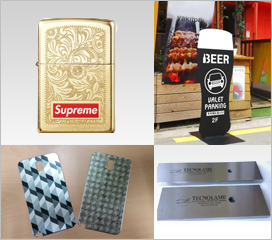Eco-solvent Substrates
Digital Flatbed Printer, Flatbed Solvent Printer Manufacturer | DMPS
Wood(UV/DT)
Wood is the best ideal substrate for UV. It normally doesn't need pretreatment but primer sometimes can be used for better quality and higher productivity

Solid Wood
solid wood is an easy printing material if surface is treated smooth by sand paper unless surface has groove face

Plywood
plywood has a similar to solid wood to print on the surface, but some needs pretreatment or primer depends on water absorbability like water based pigment or oil based varnish. Be careful with disadvantage of easy bending when printing

MDF
MDF made of saw dust is the easiest printing material but in case of white or varnish ink, it is recommendable to use primer due to its fast water absorbency

Glued laminated
wooden panel combining glued pieces of wood uses as finishing material and recommends to treat surface with sand paper utilizing primer before printing

PB
not suitable for printing material since PB uses as mostly construction purpose which has already printed from manufacturer and not necessary to pretreat if surface is coated
METAL(UV/DT)
most metal can be printed but some coated metal is not compatible, so that pretreated metallicmaterial needs pretreatment like primer

- iron, stainless, brass needs pretreatment or after treatment like primer applying to plaque, equipment attachment or signage, advertising panel that is underharshest outdoor environment( rain, wind, high temperature, sunlight)
D primer is appropriate but coating paint like mera coat will be more durable under natural circumstances - Substrates like aluminum, nickel silver doesn't need pretreatment since its surface is mostly not coated. Generally it is used for award template, but be careful when printing on anodizing coating, prints could be easily flake off.
Plastics(UV/DT/SP)
Sample printing is the common way to print on plastics, even though its variety of kind and ways to print are various

PE (X)
Polyethylene is mainly used for milk container, ink bottle, floor sheet which is not compatible to printing.
It requires corona treatment using PCM(corona pretreatment machine) after printing but not recommendable

PP (UV)
polypropylene is used for snack bag, baby feeding bottle, food container and recently tooth brush case. These substrates can be printed using PCM

PU(UV/SP)
Polyurethane is generated in different application, recently TPU(thermoplastic PU) called jelly case has a good compatibility without pretreatment and a good bondage. PU leather that fabricates well has a strong adhesiveness as well as popularity. U53H as soft UV ink or Argorink as a hybrid ink than hard one is more recommendable since PU material is not stable
ABS (UV/SP)
ABS which is combined with AS polymer and rubber polymer irregularly is good for printing, generally SP ink or 53H ink would be appropriate. As a raw material of plastic case or injection products, sometimes ABS injection products which are not compatible because of its multi chemical mixture need to be cleaned off impurities

PC (UV/SP)
polycarbonate's application is various such as bullet proof film, plastic container, milk container, injection products but due to prevention of environmentalhormone, food container and baby feeding bottle is not permitted.Cell phonecase and other injection products has been used PC dominantly to print better than PP or PE due to less chemical reaction

PS (US/DT/SP)
polystyrene is a soft plastic material, easy to break, but one of best plastic raw material for printing. Its characteristic, which its format is too soft and weak for natural environment(sunlight/UV) can change the formation or makes the crack after using the strong ink, so check there is any discrepancy after a week. SP ink or U53H is generally used and DT Ink for printing fastness

PVC (UV/DT)
poly chrolidizedvynil is generally used in film, sheet, cosmetics, cap, resin material variously. PVC pipe for construction material and raw material for artificial leather was in common but plasticizer which arose anti eco-friendly environment makes the less applicable in production.
Even though PVC is not appropriate as a printing material, some pretreatment needed for good quality of printing and DT ink after heat pressure or UV ink. U53H for PVC leather or U53HF for wooden panel or hard PVC raw material after heat pressure

Acrylic (UV)
Acrylic is strong on water, acid, alkaline but print won't stay longer. Thanks to improving technology of wood fabrication, many applications on Acrylic could be printed.
Among new fabrication of Acrylic or recycled one, we recommend to use new on since recycled one has a tendency of crack or defect and to clean off impurities to maintain the quality

Formax(UV)
DT ink with slow speed or primer has been used for Formax printing since its format is easy to transform but not easy to print but UV using U53H without pretreatment can achieve the best quality and fastness( precaution of dust and anti-static )
Glass (UV)
Generally exclusive primer to use on glass printing

Tempered glass
tempered glass making flat glass by rapid cooling after lifting up to softening point is good for printing but weak adhesion. In order to perform best quality, use primer on surface or grind the surface and print on reverse side.

Crystal
Crystal is a common raw material of transparent glass. D primer than regular primer is more applicable to clean leftover mist on surface after printing. U53H ink is mostly in common for crystal plaque.
